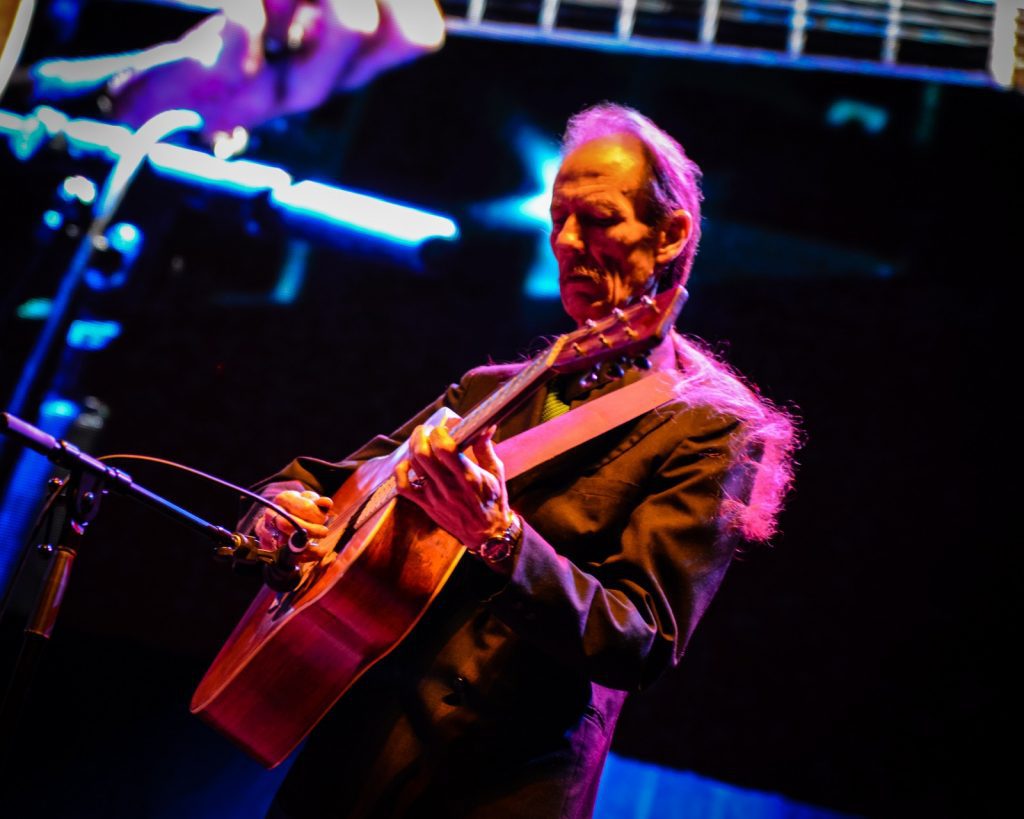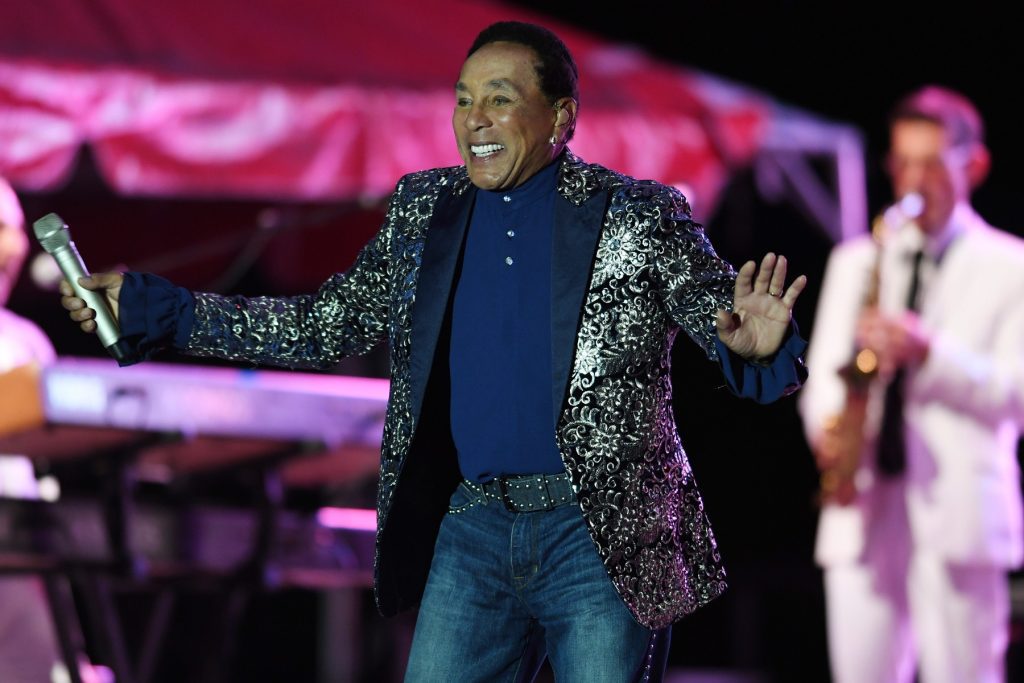
Why Tony Rice Was Bluegrass Music’s Great Experimentalist
When guitarist Tony Rice died on Christmas Day in his North Carolina home, bluegrass music bade farewell to a second-generation star who expressed his music in modern terms and embraced bluegrass’s potential to both blend with and influence other genres.
“The music business has lost a true innovator,” says Jimmy Gaudreau, who played mandolin with Rice in the Eighties and Nineties. “As far as the guitar players of today, they name Tony Rice as the number one influence.”
Rice emerged in the vanguard of bluegrass music when he joined bandleader J.D. Crowe in the early 1970s. Crowe shook up bluegrass music by inviting Rice, a lover of folk music, to bring in songs such as “Summer Wages” (Ian Tyson) and “You Are What I Am” (Gordon Lightfoot) and generously showcasing the picking and singing of Rice and the rising star Ricky Skaggs. Together with their boss, Skaggs and Rice formed the nucleus of the J.D. Crowe and the New South album released in 1975. Known affectionately today by its catalog number “0044,” many consider it the greatest album ever recorded in bluegrass. It soared on Crowe’s brisk banjo and Skaggs’ joyous tenor singing. But Rice’s solid flatpicking guitar style and heartbreaking lead vocals anchored the sound.
blogherads.adq.push(function () {
blogherads
.defineSlot( ‘medrec’, ‘gpt-dsk-tab-country-article-inbody1-uid0’ )
.setTargeting( ‘pos’, [“mid-article”,”mid”,”in-article1″,”btf”] )
.setSubAdUnitPath(“music//country//article//inbody1”)
.addSize([[300,250],[620,350],[2,2],[3,3],[2,4],[4,2]])
.setLazyLoadMultiplier(2)
;
});
Many purists sniffed at the diverse set list and freewheeling arrangements of “0044,” but 45 years later fans still celebrate the album. It ranks among the reasons that bluegrass freely accepts experimentation today.
Born in 1951 to a music-playing family in Danville, Virginia, who raised him in California, Florida, and North Carolina, Rice admired legendary guitarist Lester Flatt and the West Coast guitarist Clarence White (who joined the Byrds in the late 1960s). “He was refined, and he took what Clarence was able to do and went beyond that,” says Gaudreau.
Beginning in the 1960s, the young guitarist played in a series of regional bands, but his pace accelerated in 1970 when he took over lead vocals for the Bluegrass Alliance based in Louisville, Kentucky, which featured mandolinist Sam Bush and liberally married bluegrass and newer musical styles. “Rice was a step above most of the people who played with the band at the time,” recalls Harry Bickel, a champion of bluegrass music in Louisville in the Seventies.
Meanwhile, J.D. Crowe had hired Tony’s older brother Larry to play mandolin. In an interview from his home near Lexington, Kentucky, Crowe told IndieLand that it wasn’t long before he enlisted Tony too. On Labor Day weekend of 1971, Tony played his last gig with the Bluegrass Alliance at the bluegrass festival in Camp Springs, North Carolina, which would be filmed by director Albert Ihde for his 1972 documentary Bluegrass Country Soul. Crowe was also playing the festival and he needed the wiry lead singer as badly as the Bluegrass Alliance did. Discerning fans of the documentary classic will know that Tony appeared with both bands that weekend: in paisley with the Bluegrass Alliance and in a starched white shirt with Crowe.
Rice’s four years with Crowe was like university training. “When he first came with me,” says Crowe, “he was trying to play everything he knew in one break, and I’d tell him, ‘Play the melody of the song first. You can have your ins and outs there, but let the melody stand out first. Timing and melody, that’s what you go with.’ Nobody had ever explained it to him that way.”
Thanks to their regular gig at the Holiday Inn in Lexington, where they played five nights a week, Crowe’s band evolved into a precisely calibrated locomotive. “We had gotten to the point that we knew what each other was thinking by just looking at each other, and that’s a great feeling to have,” explains Crowe. “Tony was very good at paying attention because whatever he was playing he wanted it right, as good as he could get it. I loved that because there’s so many pickers that don’t feel that way.”
blogherads.adq.push(function () {
blogherads
.defineSlot( ‘medrec’, ‘gpt-dsk-tab-country-article-inbody2-uid1’ )
.setTargeting( ‘pos’, [“mid-article”,”mid”,”in-article2″,”btf”] )
.setSubAdUnitPath(“music//country//article//inbody2”)
.addSize([[300,250],[300,251],[620,350],[2,4],[4,2]])
.setLazyLoadMultiplier(2)
;
});
“We were not only pickers together, we were friends. Losing Tony was like losing a brother.” – J.D. Crowe
In the wake of the innovative “0044,” Rice met jazz-folk-bluegrass fusionist David Grisman in California. “Grisman came home with me to Kentucky and he sat in and played a couple of nights with the New South, which was the last configuration of the New South that I was in,” Rice told writer Barry R. Willis. “And then, from there on, we befriended each other and we started talking on the phone occasionally, just to shoot the breeze more or less. And it was sometime in the summer of that year that we started talking seriously about collaboration on something — be it a group project, or a recording, or whatever.”
But before Rice left to join the David Grisman Quintet in late 1975, he played one more gig with Crowe. “Tony had already been with me about four years almost and I knew he was getting tired, I could tell it,” says Crowe. “And he had already told me about making a move and I said, ‘I hate to lose you, but you got to do what you want to do. I appreciate you even mentioning it. I can’t blame you. I hate it, but I understand.’ The last show we did was in Japan, 1975, and I tell you this, the last song we sung when we walked off the stage, he had tears in his eyes. He couldn’t hardly talk to me. We were not only pickers together, we were friends. Losing Tony was like losing a brother.”
With Grisman, Rice studied musical theory and flourished as the band carried his beloved bluegrass into the jazz realm, factors that moved him to go out on his own as the Tony Rice Unit in 1979. Originally conceived of as an instrumental group, the band would go on to record several albums for Rounder, including 1979’s highly regarded Manzanita, which blended jazz, folk, and bluegrass and featured his former bandmates Ricky Skaggs and Sam Bush.
“I’m a bluegrass musician forever in my heart,” he told Bluegrass Unlimited in the 1980s, mindful, perhaps, of those who may have assumed he’d abandoned his roots. “But I want to explore and unearth some other things along the way. When I think that piano, drums and soprano saxophone are appropriate, I add them. I really wanted to get out of restricting myself to one format. But I am very much a guitar player, but the challenge of the music lies elsewhere now.”
A failed relationship in California pointed him back to the east, where he reformed the Tony Rice Unit with an eye on returning his vocals to the fore. After a series of jazz-influenced instrumental albums, he dusted off his folk-influenced vocals for the solo albums Church Street Blues in 1983 and 1984’s Cold on the Shoulder, the latter featuring instrumentalists Béla Fleck, Vassar Clements, and Jerry Douglas. The larger bluegrass audience had grown accustomed to progressive bluegrass thanks to bands like New Grass Revival and even the experimentation of J.D. Crowe, so it wasn’t hard to sell the experimental elements that had become part of Rice’s sound to bluegrass fans.
blogherads.adq.push(function () {
blogherads
.defineSlot( ‘medrec’, ‘gpt-dsk-tab-country-article-inbodyX-uid2’ )
.setTargeting( ‘pos’, [“mid-article”,”mid-articleX”,”mid”,”in-articleX”,”btf”] )
.setSubAdUnitPath(“music//country//article//inbodyX”)
.addSize([[300,250],[300,251],[3,3],[620,350]])
.setLazyLoadMultiplier(2)
;
});
“It was fresh,” says Gaudreau, who joined the Unit in the 1980s. “It was, ‘Tony Rice is back and he’s singing.’ That was the battle cry going around the bluegrass circuit. ‘And he’s got a group that will absolutely send you over the top.’ We toughed it out for a while, but once the word got around everybody wanted it. Tony was like singing with a vocal machine. He was just spot on, always on pitch, never threw you any curves. It was always fastballs.”
Becoming the teacher that Crowe and Grisman had been to him, Rice allowed sidemen to prosper. “Without a doubt, it was the most educational experience that I’ve had in music,” says Gaudreau. “As far as getting to know my instrument better, becoming a more proficient player and developing an appreciation for where music can go — he showed me the way. He showed me that there are ways to play music that are based in tradition but that you can put your own stamp on. Everything Tony Rice played and sang he signed his name to.”
As if to remind the audience of his bluegrass soul, Rice assembled Crowe, tenor singer Doyle Lawson, fiddler Bobby Hicks, and bassist Todd Phillips in 1981 to make The Bluegrass Album for Rounder. “We got halfway through the first album,” says Crowe, “and we were listening to playback and me and Tony were standing side by side and he looked at me and said, ‘Crowe. This is too good. We can’t let this go at one album. We need to do more than one.’” Indeed, that group, which became known as the Bluegrass Album Band, recorded five additional albums, comprising the last great chapter in Rice’s recording career.
“But by the fourth album we did, I could tell Tony’s voice wasn’t as good as it had been,” continues Crowe. “That’s when I noticed his vocals going down slightly. He was straining to do things that he didn’t used to strain to do.” In simple terms, years of over-singing and tobacco and alcohol consumption had damaged his throat. Doctors called it “dysphonia” and by the mid-1990s it had so advanced that the Bluegrass Album Band had to cap its career with an instrumental collection.
Gaudreau saw Rice’s reckoning with his deteriorating heath at the 1994 Gettysburg Bluegrass Festival where Rice and Ricky Skaggs and other members of the New South performed a reunion concert. “His voice was already giving out,” Gaudreau says. “It was raspy. For a couple of years he had pushed it harder and harder until it couldn’t function anymore. On that particular show, he looked at Ricky and kind of shook his head and when he came off stage. [Fiddler] Rickie Simpkins and I were standing there and he walked by us and said in his raspy, growling voice, with whatever he had left, ‘I ain’t singing anymore.’”
blogherads.adq.push(function () {
blogherads
.defineSlot( ‘medrec’, ‘gpt-dsk-tab-country-article-inbodyX-uid3’ )
.setTargeting( ‘pos’, [“mid-article”,”mid-articleX”,”mid”,”in-articleX”,”btf”] )
.setSubAdUnitPath(“music//country//article//inbodyX”)
.addSize([[300,250],[300,251],[3,3],[620,350]])
.setLazyLoadMultiplier(2)
;
});
Despite his handicap and other health problems, Rice pressed on as a guitarist. He remained a force on the instrument and a guiding light to younger players. Fans never tired of seeing his small pick-up truck with North Carolina tags pull into the festival parking lot just before show time.
Occasionally, the Bluegrass Album Band reunited for gigs, the last one in Asheville, North Carolina, in 2013. “It was after he had gotten feeling pretty bad, and he didn’t know if he could make it or not and they booked that show that way,” recalls Crowe. “I had a guy standing by to help us out and do Tony’s part if he couldn’t make it. He did good, but I could tell that it wasn’t like the Tony I knew. We did the show and we did two encores and when we walked off the stage, he looked at me and said, ‘Crowe, I am wore out.’ That’s the words he said. I could tell. I said, ‘Tony you did great. I know you’re tired, but you pulled it off, buddy.’ He kind of grinned. From there he went downhill.”
Rice continued to call his old teacher in August for his birthday, whistling his greetings for Crowe when it became too difficult to speak. But Rice failed to call this year, so when the phone rang the day after Christmas, he wasn’t surprised to learn that the innovator’s body had finally failed him.
To this day, Crowe marvels at Rice’s talent, whether he was commanding the microphone, picking out a lead on his Martin D-28, or gracefully laying back while others took a solo. “Tony was probably about my favorite rhythm guitar player. As far as a singer, as far as timing and singing and knowing where to put it, he was the man,” Crowe says. “When he learned it and stayed there, he never forgot it.”




